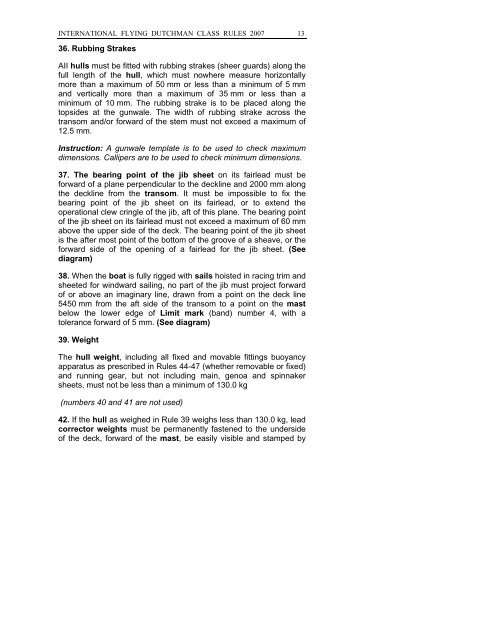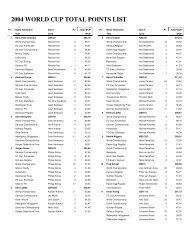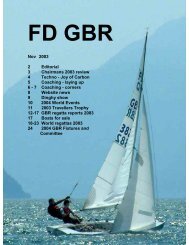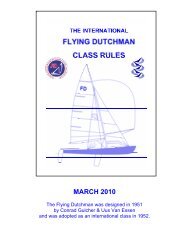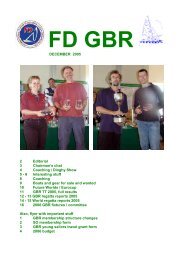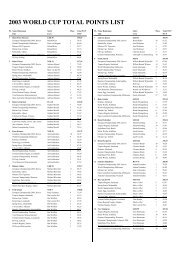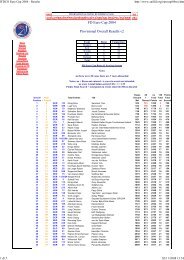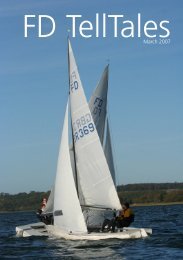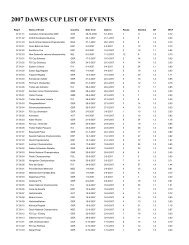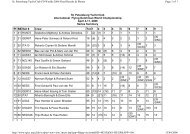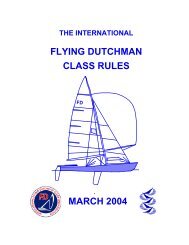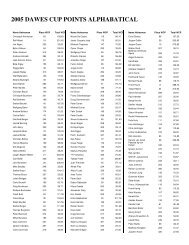A5 version - International Flying Dutchman Class
A5 version - International Flying Dutchman Class
A5 version - International Flying Dutchman Class
You also want an ePaper? Increase the reach of your titles
YUMPU automatically turns print PDFs into web optimized ePapers that Google loves.
INTERNATIONAL FLYING DUTCHMAN CLASS RULES 2007 13<br />
36. Rubbing Strakes<br />
AII hulls must be fitted with rubbing strakes (sheer guards) along the<br />
full length of the hull, which must nowhere measure horizontally<br />
more than a maximum of 50 mm or less than a minimum of 5 mm<br />
and vertically more than a maximum of 35 mm or less than a<br />
minimum of 10 mm. The rubbing strake is to be placed along the<br />
topsides at the gunwale. The width of rubbing strake across the<br />
transom and/or forward of the stem must not exceed a maximum of<br />
12.5 mm.<br />
Instruction: A gunwale template is to be used to check maximum<br />
dimensions. Callipers are to be used to check minimum dimensions.<br />
37. The bearing point of the jib sheet on its fairlead must be<br />
forward of a plane perpendicular to the deckline and 2000 mm along<br />
the deckline from the transom. It must be impossible to fix the<br />
bearing point of the jib sheet on its fairlead, or to extend the<br />
operational clew cringle of the jib, aft of this plane. The bearing point<br />
of the jib sheet on its fairlead must not exceed a maximum of 60 mm<br />
above the upper side of the deck. The bearing point of the jib sheet<br />
is the after most point of the bottom of the groove of a sheave, or the<br />
forward side of the opening of a fairlead for the jib sheet. (See<br />
diagram)<br />
38. When the boat is fully rigged with sails hoisted in racing trim and<br />
sheeted for windward sailing, no part of the jib must project forward<br />
of or above an imaginary line, drawn from a point on the deck line<br />
5450 mm from the aft side of the transom to a point on the mast<br />
below the lower edge of Limit mark (band) number 4, with a<br />
tolerance forward of 5 mm. (See diagram)<br />
39. Weight<br />
The hull weight, including all fixed and movable fittings buoyancy<br />
apparatus as prescribed in Rules 44-47 (whether removable or fixed)<br />
and running gear, but not including main, genoa and spinnaker<br />
sheets, must not be less than a minimum of 130.0 kg<br />
(numbers 40 and 41 are not used)<br />
42. If the hull as weighed in Rule 39 weighs less than 130.0 kg, lead<br />
corrector weights must be permanently fastened to the underside<br />
of the deck, forward of the mast, be easily visible and stamped by


